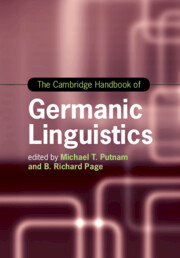Book contents
- The Cambridge Handbook of Germanic Linguistics
- Cambridge Handbooks in Language and Linguistics
- The Cambridge Handbook of Germanic Linguistics
- Copyright page
- Contents
- Figures
- Maps
- Tables
- Contributors
- Acknowledgments
- Germanic Languages
- Part I Phonology
- Part II Morphology and Agreement Systems
- Part III Syntax
- Chapter 15 VO-/OV-Base Ordering
- Chapter 16 The Placement of Finite Verbs
- Chapter 17 Germanic Infinitives
- Chapter 18 The Unification of Object Shift and Object Scrambling
- Chapter 19 Unbounded Dependency Constructions in Germanic
- Chapter 20 The Voice Domain in Germanic
- Chapter 21 Binding
- Chapter 22 Verbal Particles, Results, and Directed Motion
- Chapter 23 Structure of Noun (NP) and Determiner Phrases (DP)
- Part IV Semantics and Pragmatics
- Part V Language Contact and Nonstandard Varieties
- Index
- References
Chapter 21 - Binding
The Morphology, Syntax, and Semantics of Reflexive and Nonreflexive Pronouns
from Part III - Syntax
Published online by Cambridge University Press: 31 March 2020
- The Cambridge Handbook of Germanic Linguistics
- Cambridge Handbooks in Language and Linguistics
- The Cambridge Handbook of Germanic Linguistics
- Copyright page
- Contents
- Figures
- Maps
- Tables
- Contributors
- Acknowledgments
- Germanic Languages
- Part I Phonology
- Part II Morphology and Agreement Systems
- Part III Syntax
- Chapter 15 VO-/OV-Base Ordering
- Chapter 16 The Placement of Finite Verbs
- Chapter 17 Germanic Infinitives
- Chapter 18 The Unification of Object Shift and Object Scrambling
- Chapter 19 Unbounded Dependency Constructions in Germanic
- Chapter 20 The Voice Domain in Germanic
- Chapter 21 Binding
- Chapter 22 Verbal Particles, Results, and Directed Motion
- Chapter 23 Structure of Noun (NP) and Determiner Phrases (DP)
- Part IV Semantics and Pragmatics
- Part V Language Contact and Nonstandard Varieties
- Index
- References
Summary
This chapter discusses anaphoric elements, i.e., reflexive and nonreflexive pronouns, their syntactic distribution, their morphological structure, and how they get their reference (their semantics). While the main goal is to give a descriptive overview, the chapter also introduces two landmark theories proposed to account for the distribution of anaphoric elements: Chomsky’s (1981, 1986) classic Binding Theory and Reinhart and Reuland’s (1993) “Reflexivity” approach. The initial concern is with the basic complementarity of reflexive and nonreflexive pronouns in English and German but also with certain instances of noncomplementarity, including logophoric uses of reflexive pronouns in English. The chapter then deals with anaphoric elements in Dutch, Norwegian, Danish, Swedish, and Icelandic, focusing on so-called SELF versus SE anaphors, and, where applicable, also on possessive reflexives. Special attention is paid to the comparison between Dutch zichzelf and German sich (selbst).
Keywords
- Type
- Chapter
- Information
- The Cambridge Handbook of Germanic Linguistics , pp. 493 - 515Publisher: Cambridge University PressPrint publication year: 2020

